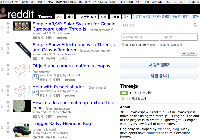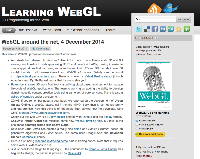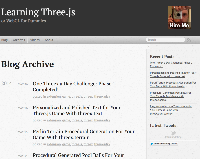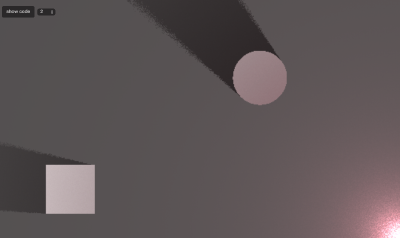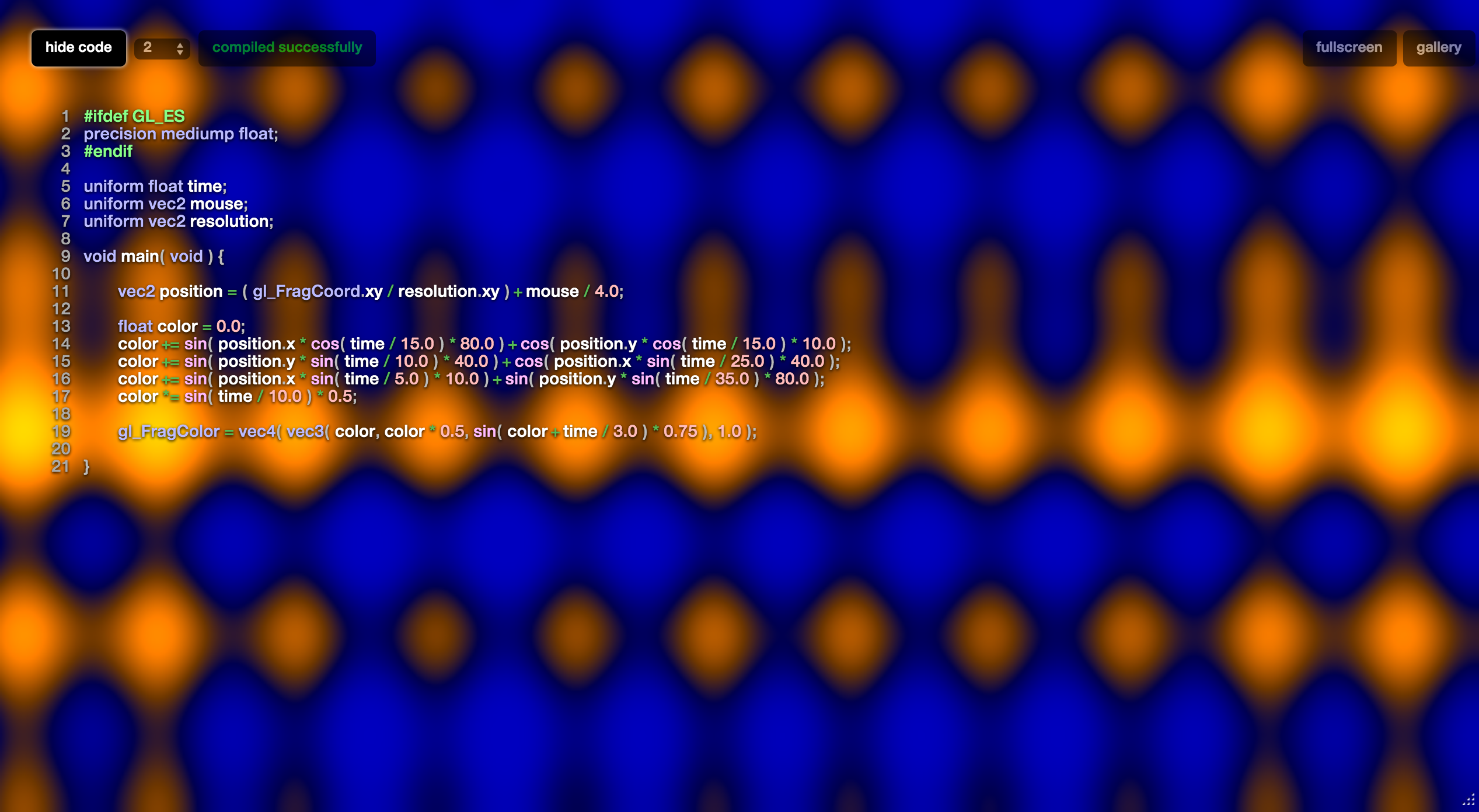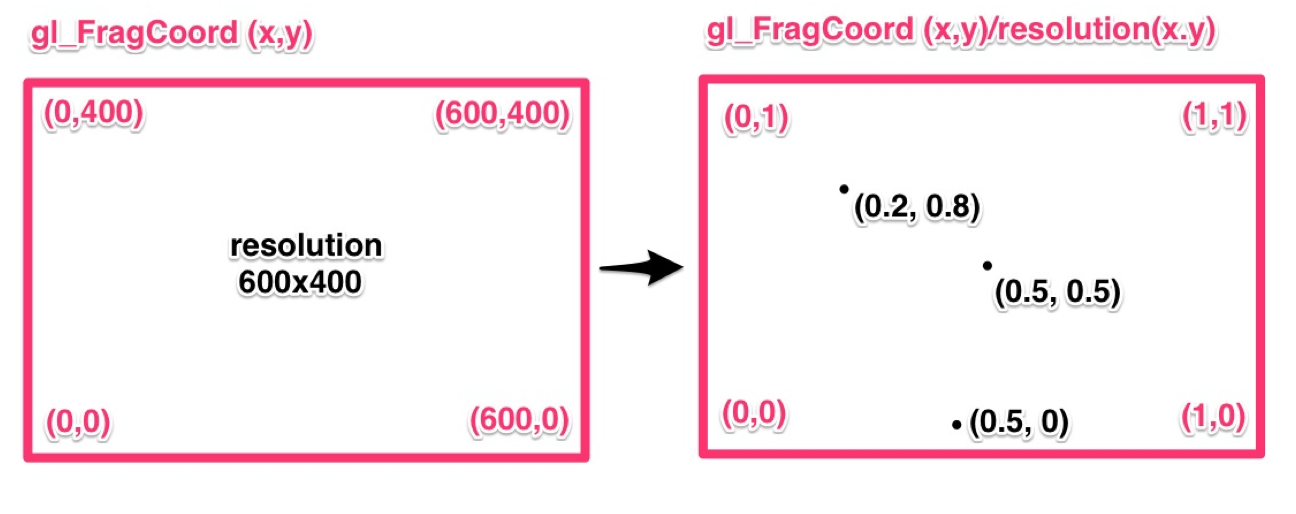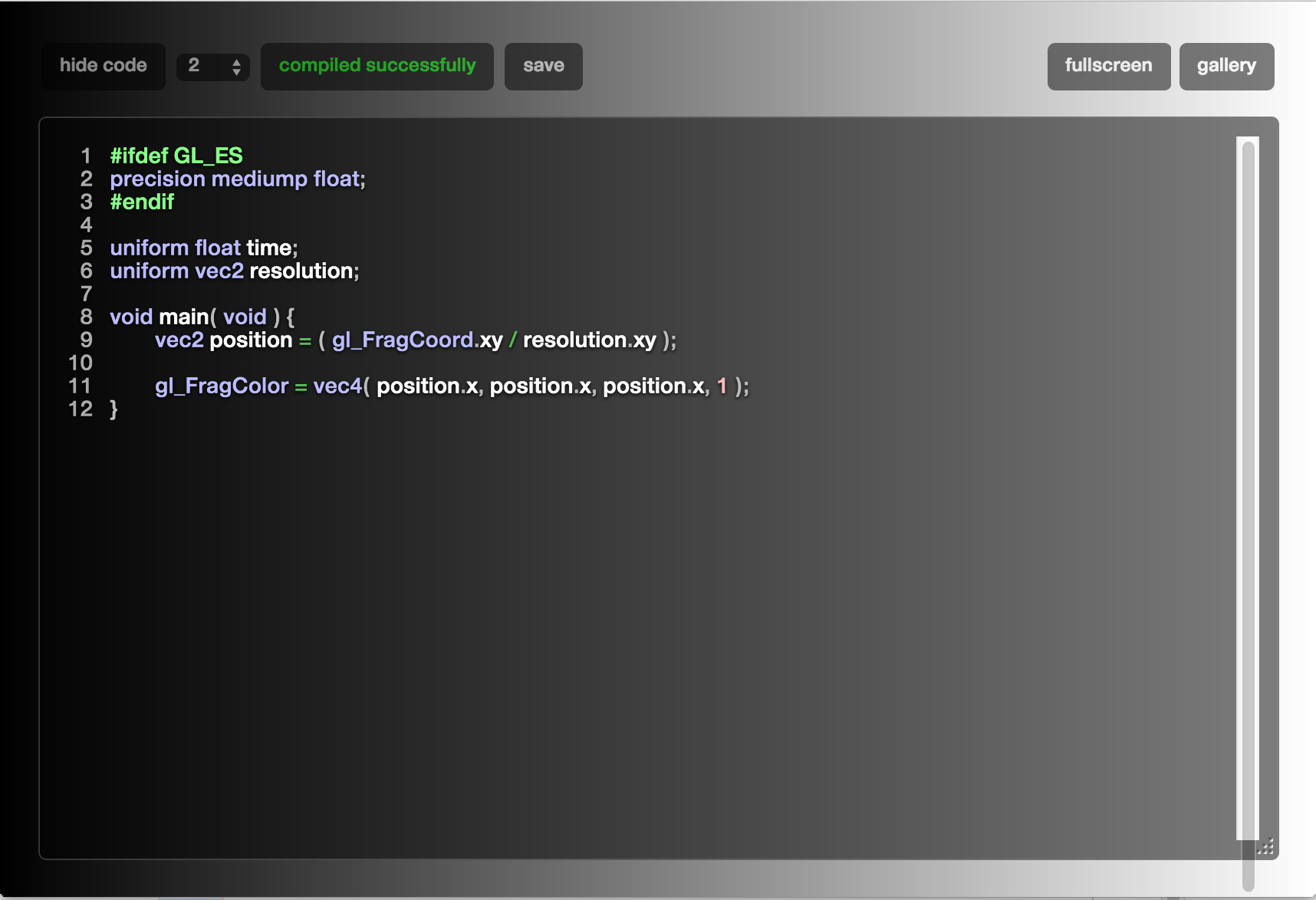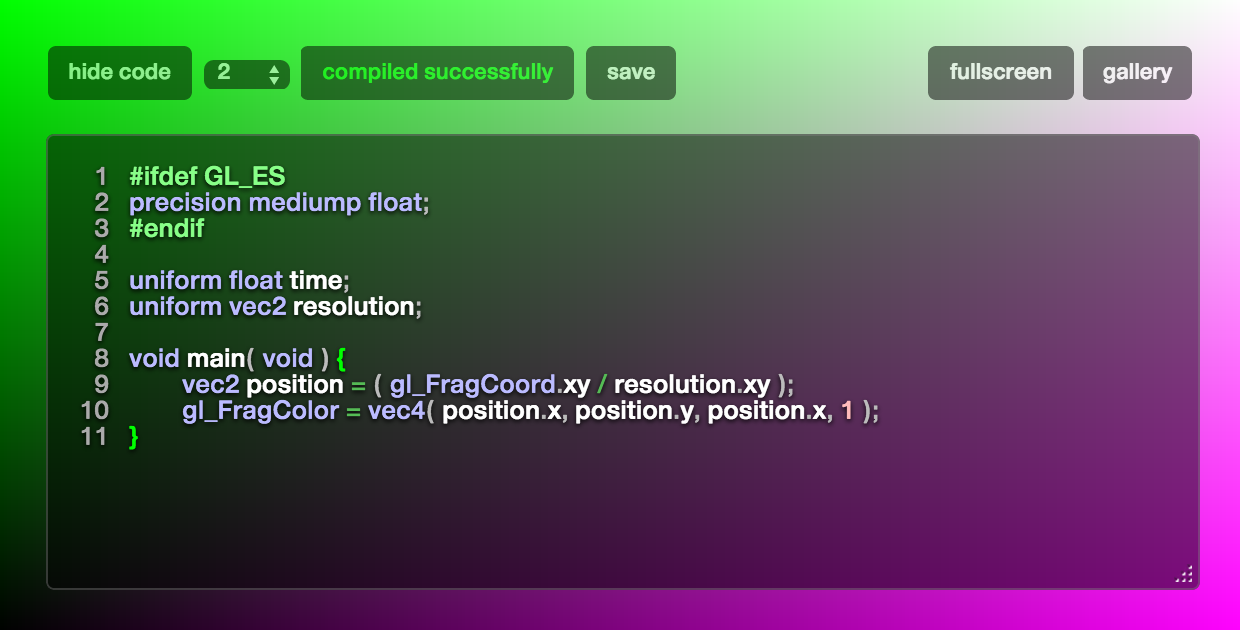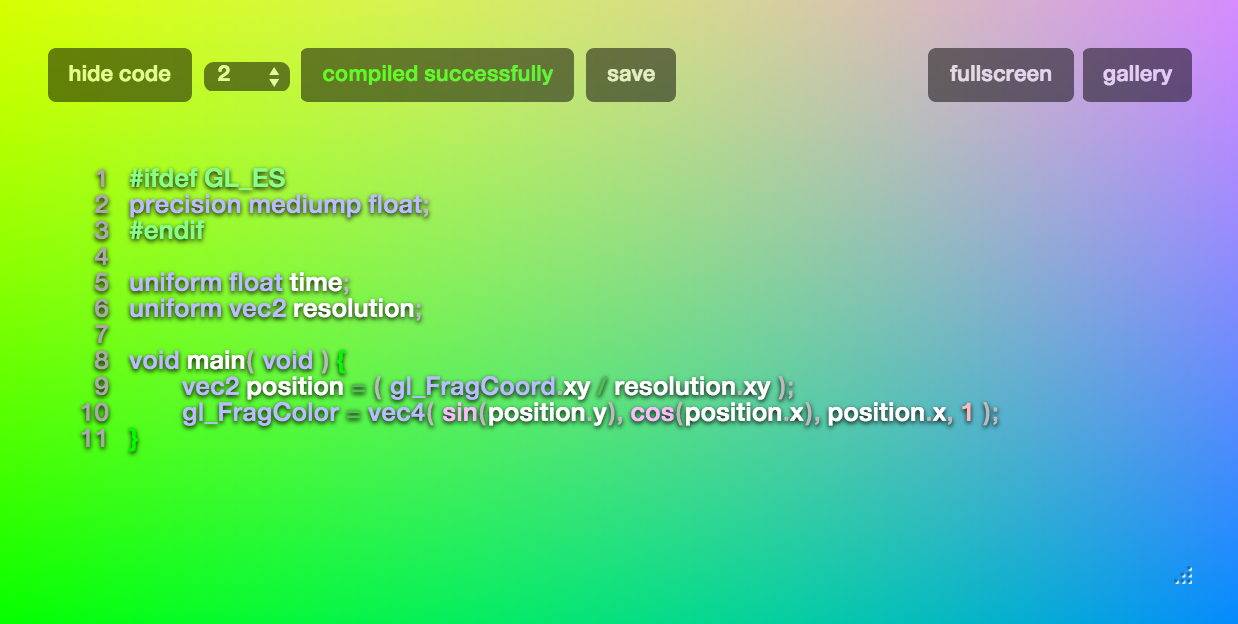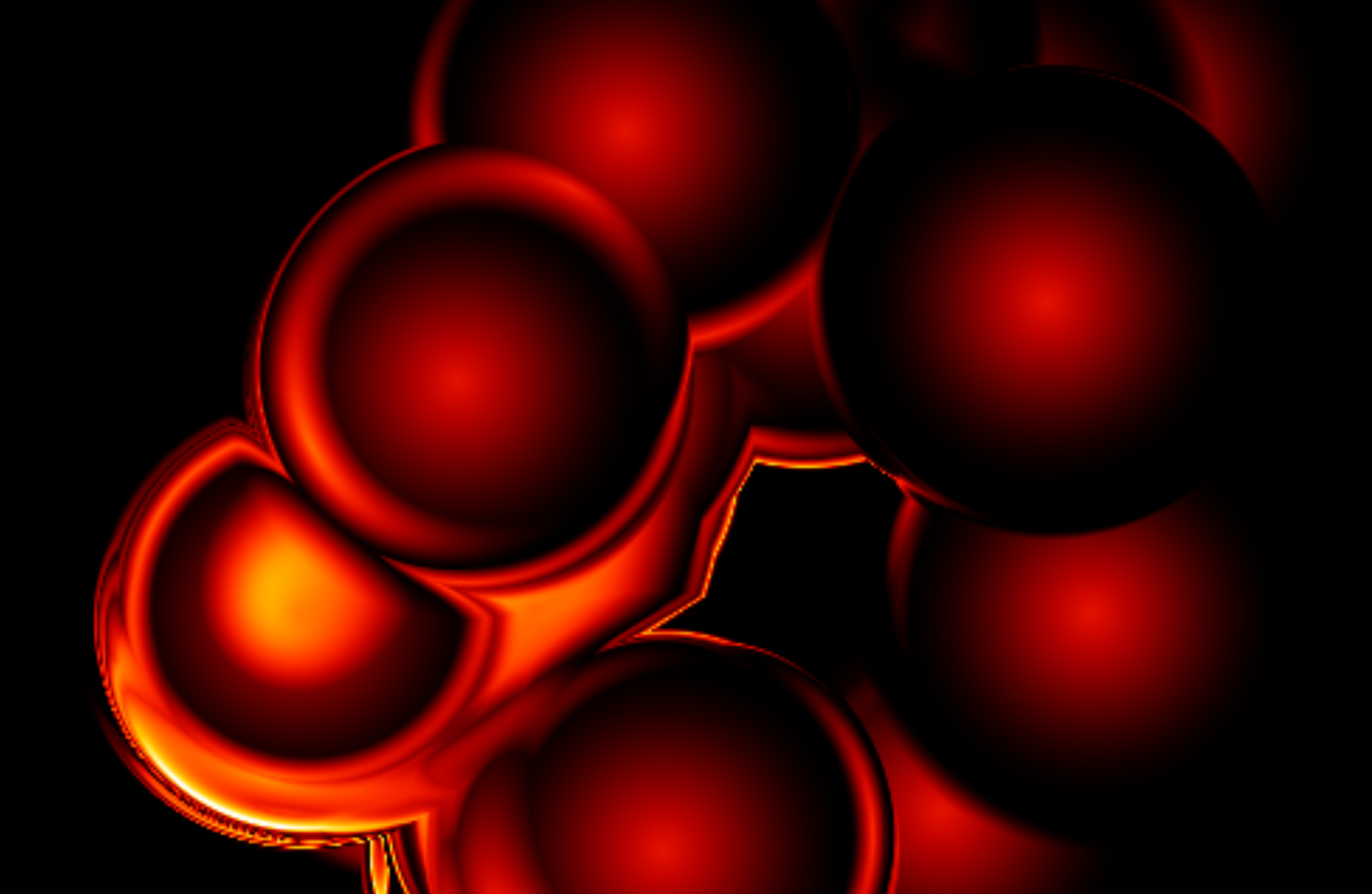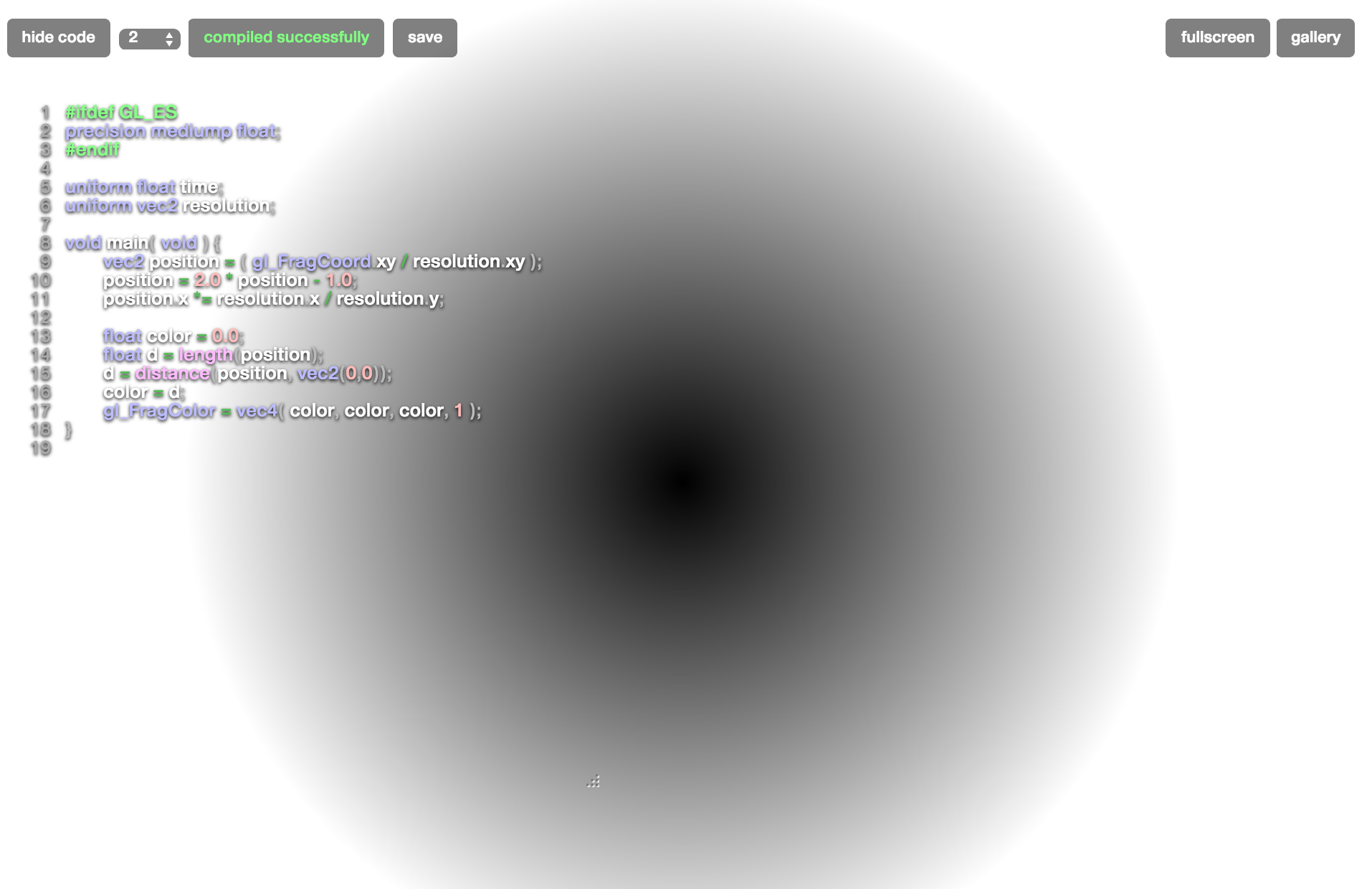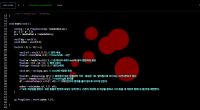굉장하다!
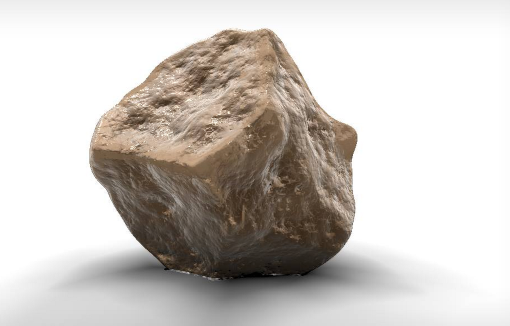
http://glslsandbox.com/e#20806
#ifdef GL_ES
precision mediump float;
#endif
uniform float time;
uniform vec2 mouse;
uniform vec2 resolution;
vec3 iMouse=vec3(time*50.0);
vec2 iResolution=resolution;
float iGlobalTime=time;
// "Wet stone" by Alexander Alekseev aka TDM - 2014
// License Creative Commons Attribution-NonCommercial-ShareAlike 3.0 Unported License.
// Mahmud Yuldashev modification mahmud9935@gmail.com
#define SMOOTH
const int NUM_STEPS = 32;
const int AO_SAMPLES = 3;
const vec2 AO_PARAM = vec2(1.2, 3.8);
const vec2 CORNER_PARAM = vec2(0.25, 40.0);
const float INV_AO_SAMPLES = 1.0 / float(AO_SAMPLES);
const float TRESHOLD = 0.1;
const float EPSILON = 1e-4;
const float LIGHT_INTENSITY = 0.25;
const vec3 RED = vec3(1.0,0.7,0.7) * LIGHT_INTENSITY;
const vec3 ORANGE = vec3(1.0,0.67,0.43) * LIGHT_INTENSITY;
const vec3 BLUE = vec3(0.54,0.77,1.0) * LIGHT_INTENSITY;
const vec3 WHITE = vec3(1.2,1.07,0.98) * LIGHT_INTENSITY;
const float DISPLACEMENT = 0.1;
// math
mat3 fromEuler(vec3 ang) {
vec2 a1 = vec2(sin(ang.x),cos(ang.x));
vec2 a2 = vec2(sin(ang.y),cos(ang.y));
vec2 a3 = vec2(sin(ang.z),cos(ang.z));
mat3 m;
m[0] = vec3(a1.y*a3.y+a1.x*a2.x*a3.x,a1.y*a2.x*a3.x+a3.y*a1.x,-a2.y*a3.x);
m[1] = vec3(-a2.y*a1.x,a1.y*a2.y,a2.x);
m[2] = vec3(a3.y*a1.x*a2.x+a1.y*a3.x,a1.x*a3.x-a1.y*a3.y*a2.x,a2.y*a3.y);
return m;
}
float hash11(float p) {
return fract(sin(p * 727.1)*43758.5453123);
}
float hash12(vec2 p) {
float h = dot(p,vec2(127.1,311.7));
return fract(sin(h)*43758.5453123);
}
vec3 hash31(float p) {
vec3 h = vec3(1275.231,4461.7,7182.423) * p;
return fract(sin(h)*43758.543123);
}
// 3d noise
float noise_3(in vec3 p) {
//p += 123.0;
vec3 i = floor(p);
vec3 f = fract(p);
vec3 u = f*f*(3.0-2.0*f);
vec2 ii = i.xy + i.z * vec2(5.0);
float a = hash12( ii + vec2(0.0,0.0) );
float b = hash12( ii + vec2(1.0,0.0) );
float c = hash12( ii + vec2(0.0,1.0) );
float d = hash12( ii + vec2(1.0,1.0) );
float v1 = mix(mix(a,b,u.x), mix(c,d,u.x), u.y);
ii += vec2(5.0);
a = hash12( ii + vec2(0.0,0.0) );
b = hash12( ii + vec2(1.0,0.0) );
c = hash12( ii + vec2(0.0,1.0) );
d = hash12( ii + vec2(1.0,1.0) );
float v2 = mix(mix(a,b,u.x), mix(c,d,u.x), u.y);
return max(mix(v1,v2,u.z),0.0);
}
// fBm
float fbm3(vec3 p, float a, float f) {
return noise_3(p);
}
float fbm3_high(vec3 p, float a, float f) {
float ret = 0.0;
float amp = 1.0;
float frq = 1.0;
for(int i = 0; i < 4; i++) {
float n = pow(noise_3(p * frq),2.0);
ret += n * amp;
frq *= f;
amp *= a * (pow(n,0.2));
}
return ret;
}
// lighting
float diffuse(vec3 n,vec3 l,float p) { return pow(max(dot(n,l),0.0),p); }
float specular(vec3 n,vec3 l,vec3 e,float s) {
float nrm = (s + 8.0) / (3.1415 * 8.0);
return pow(max(dot(reflect(e,n),l),0.0),s) * nrm;
}
// distance functions
float plane(vec3 gp, vec4 p) {
return dot(p.xyz,gp+p.xyz*p.w);
}
float sphere(vec3 p,float r) {
return length(p)-r;
}
float capsule(vec3 p,float r,float h) {
p.y -= clamp(p.y,-h,h);
return length(p)-r;
}
float cylinder(vec3 p,float r,float h) {
return max(abs(p.y/h),capsule(p,r,h));
}
float box(vec3 p,vec3 s) {
p = abs(p)-s;
return max(max(p.x,p.y),p.z);
}
float rbox(vec3 p,vec3 s) {
p = abs(p)-s;
return length(p-min(p,0.0));
}
float quad(vec3 p,vec2 s) {
p = abs(p) - vec3(s.x,0.0,s.y);
return max(max(p.x,p.y),p.z);
}
// boolean operations
float boolUnion(float a,float b) { return min(a,b); }
float boolIntersect(float a,float b) { return max(a,b); }
float boolSub(float a,float b) { return max(a,-b); }
// smooth operations. thanks to iq
float boolSmoothIntersect(float a, float b, float k ) {
float h = clamp(0.5+0.5*(b-a)/k, 0.0, 1.0);
return mix(a,b,h) + k*h*(1.0-h);
}
float boolSmoothSub(float a, float b, float k ) {
return boolSmoothIntersect(a,-b,k);
}
// world
float rock(vec3 p) {
float d = sphere(p,1.0);
for(int i = 0; i < 9; i++) {
float ii = float(i);
float r = 2.5 + hash11(ii);
vec3 v = normalize(hash31(ii) * 2.0 - 1.0);
#ifdef SMOOTH
d = boolSmoothSub(d,sphere(p+v*r,r * 0.8), 0.03);
#else
d = boolSub(d,sphere(p+v*r,r * 0.8));
#endif
}
return d;
}
float map(vec3 p) {
float d = rock(p) + fbm3(p*4.0,0.4,2.96) * DISPLACEMENT;
d = boolUnion(d,plane(p,vec4(0.0,1.0,0.0,1.0)));
return d;
}
float map_detailed(vec3 p) {
float d = rock(p) + fbm3_high(p*4.0,0.4,2.96) * DISPLACEMENT;
d = boolUnion(d,plane(p,vec4(0.0,1.0,0.0,1.0)));
return d;
}
// tracing
vec3 getNormal(vec3 p, float dens) {
vec3 n;
n.x = map_detailed(vec3(p.x+EPSILON,p.y,p.z));
n.y = map_detailed(vec3(p.x,p.y+EPSILON,p.z));
n.z = map_detailed(vec3(p.x,p.y,p.z+EPSILON));
return normalize(n-map_detailed(p));
}
vec2 getOcclusion(vec3 p, vec3 n) {
vec2 r = vec2(0.0);
for(int i = 0; i < AO_SAMPLES; i++) {
float f = float(i)*INV_AO_SAMPLES;
float hao = 0.01+f*AO_PARAM.x;
float hc = 0.01+f*CORNER_PARAM.x;
float dao = map(p + n * hao) - TRESHOLD;
float dc = map(p - n * hc) - TRESHOLD;
r.x += clamp(hao-dao,0.0,1.0) * (1.0-f);
r.y += clamp(hc+dc,0.0,1.0) * (1.0-f);
}
r.x = pow(clamp(1.0-r.x*INV_AO_SAMPLES*AO_PARAM.y,0.0,1.0),0.5);
r.y = clamp(r.y*INV_AO_SAMPLES*CORNER_PARAM.y,0.0,1.0);
return r;
}
vec2 spheretracing(vec3 ori, vec3 dir, out vec3 p) {
vec2 td = vec2(0.0);
for(int i = 0; i < NUM_STEPS; i++) {
p = ori + dir * td.x;
td.y = map(p);
if(td.y < TRESHOLD) break;
td.x += (td.y-TRESHOLD) * 0.9;
}
return td;
}
// stone
vec3 getStoneColor(vec3 p, float c, vec3 l, vec3 n, vec3 e) {
c = min(c + pow(noise_3(vec3(p.x*20.0,0.0,p.z*20.0)),70.0) * 8.0, 1.0);
float ic = pow(1.0-c,0.5);
vec3 base = vec3(0.42,0.3,0.2) * 0.6;
vec3 sand = vec3(0.51,0.41,0.32);
vec3 color = mix(base,sand,c);
float f = pow(1.0 - max(dot(n,-e),0.0), 1.5) * 0.75 * ic;
color = mix(color,vec3(1.0),f);
color += vec3(diffuse(n,l,0.5) * WHITE);
color += vec3(specular(n,l,e,8.0) * WHITE * 1.5 * ic);
n = normalize(n - normalize(p) * 0.4);
color += vec3(specular(n,l,e,80.0) * WHITE * 1.5 * ic);
return color;
}
// main
void main(void) {
vec2 iuv = gl_FragCoord.xy / iResolution.xy * 2.0 - 1.0;
vec2 uv = iuv;
uv.x *= iResolution.x / iResolution.y;
float time = iGlobalTime * 0.3;
// ray
vec3 ang = vec3(0.0,0.2,time);
if(iMouse.z > 0.0) ang = vec3(0.0,clamp(2.0-iMouse.y*0.01,0.0,3.1415),iMouse.x*0.01);
mat3 rot = fromEuler(ang);
vec3 ori = vec3(0.0,0.0,2.8);
vec3 dir = normalize(vec3(uv.xy,-2.0));
ori = ori * rot;
dir = dir * rot;
// tracing
vec3 p;
vec2 td = spheretracing(ori,dir,p);
vec3 n = getNormal(p,td.y);
vec2 occ = getOcclusion(p,n);
vec3 light = normalize(vec3(0.0,1.0,0.0));
// color
vec3 color = vec3(1.0);
if(td.x < 3.5 && p.y > -0.89) color = getStoneColor(p,occ.y,light,n,dir);
color *= occ.x;
// background
color = mix(vec3(1.0),color,step(td.y,1.0));
// post
float vgn = smoothstep(1.2,0.7,abs(iuv.y)) * smoothstep(1.1,0.8,abs(iuv.x));
color *= 1.0 - (1.0 - vgn) * 0.15;
gl_FragColor = vec4(color,1.0);
}
Tags : #shader
